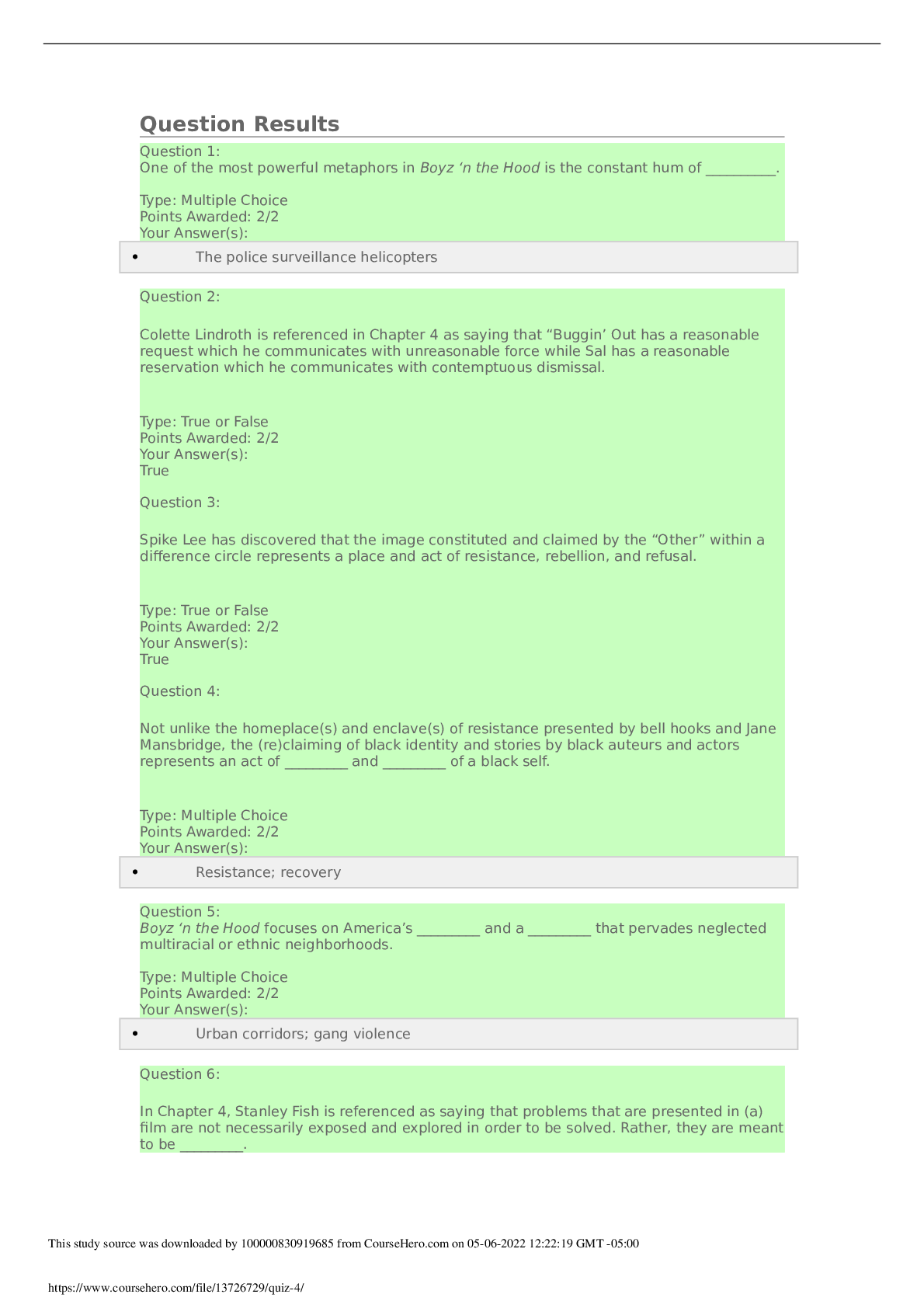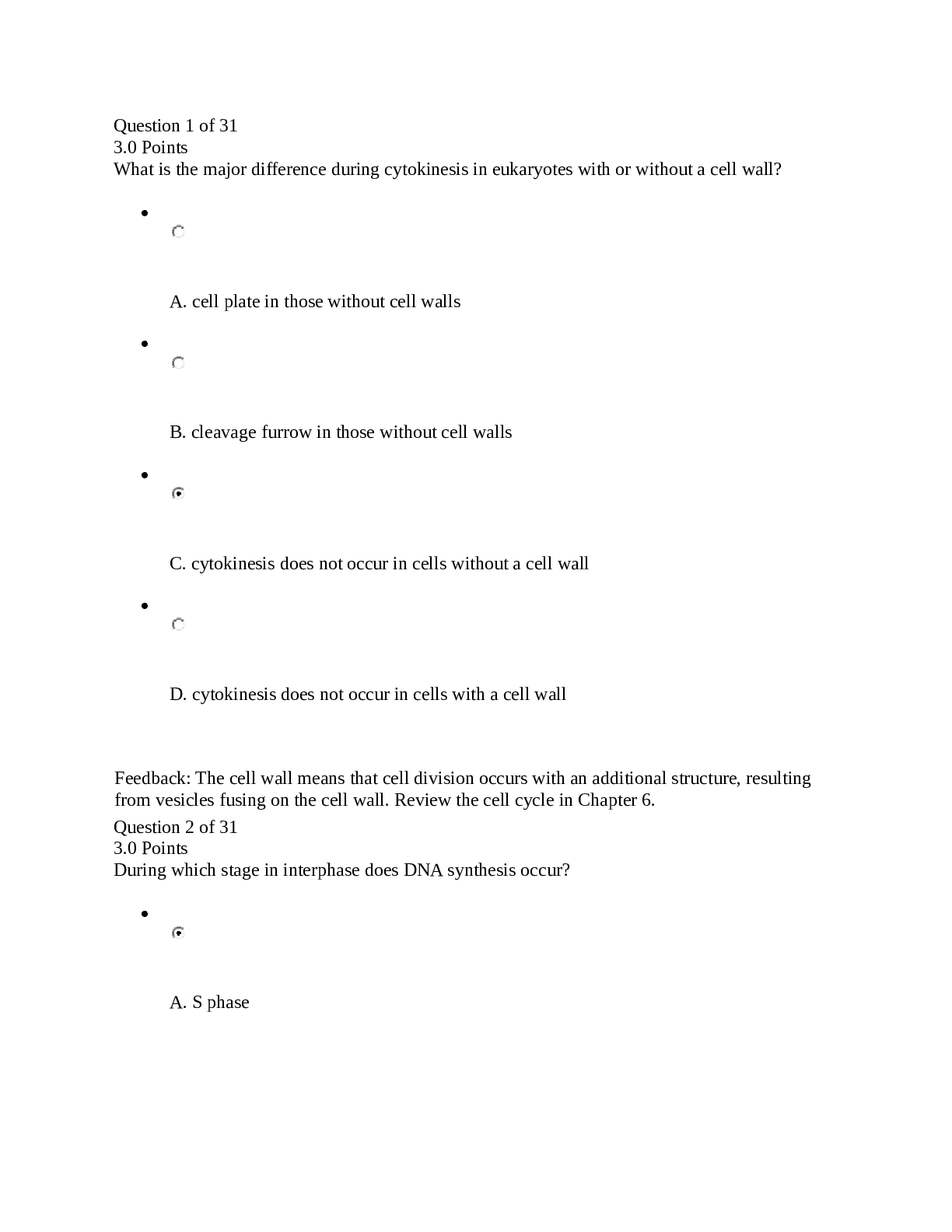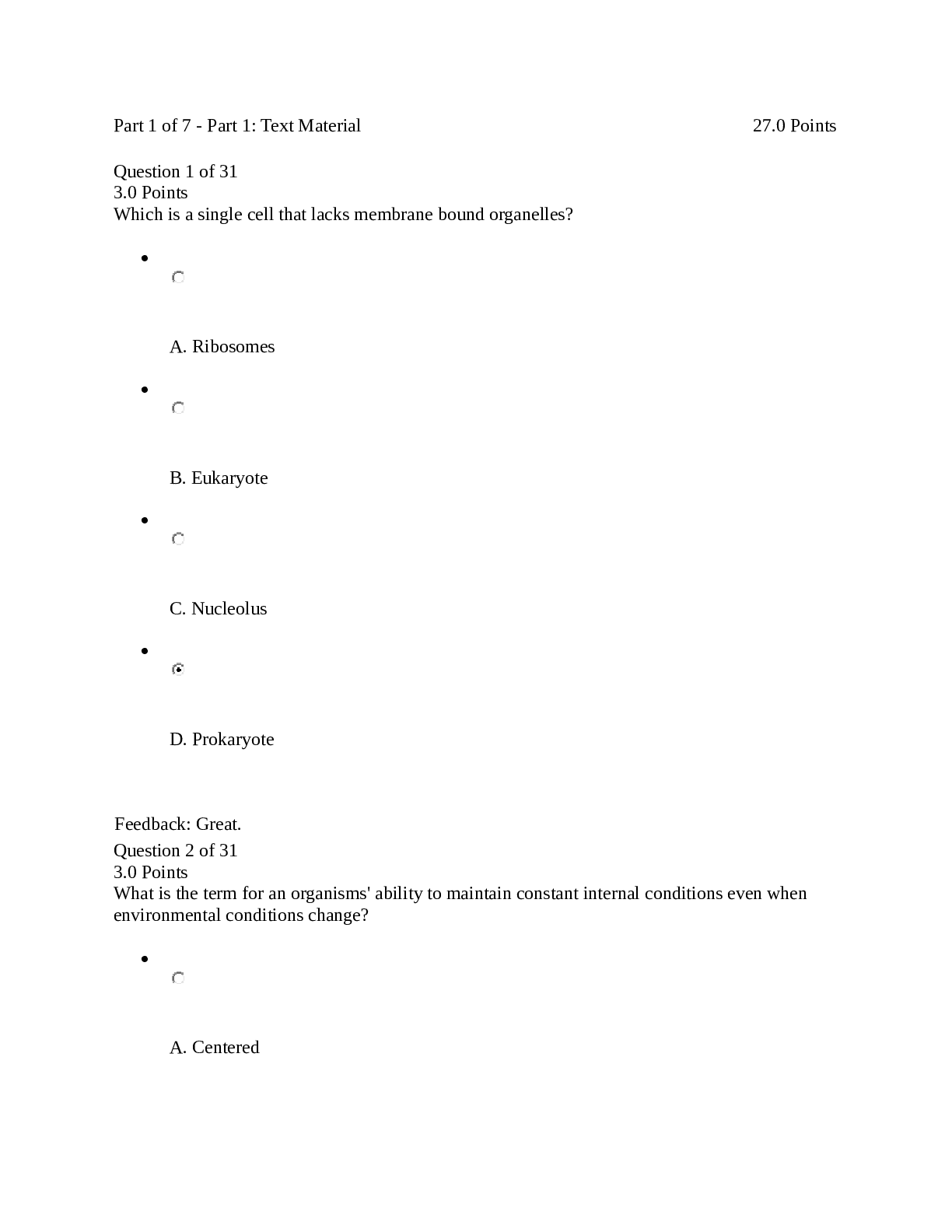Biology > Quiz > American Military University SCIN 130 Introducton to Biology Quiz 8. All 31 QnA, Rated 100% (All)
American Military University SCIN 130 Introducton to Biology Quiz 8. All 31 QnA, Rated 100%
Document Content and Description Below
Quiz 8 Return to Assessment List Part 1 of 7 - Chapter 20 Question 1 of 31 27.0 Points Because the desert has extreme temperatures and a shortage of water, what type of net primary productivit... y does it have? • A. productive • B. medium • C. high • D. low Feedback:Great job. Question 2 of 31 What is a food web that includes decomposers and detritivores called? • A. Carnivorous food web • B. Grazing food web • C. Herbivorous food web • D. Detrital food web Feedback:Great job. Question 3 of 31 Because the tropical rainforest has warm temperatures, abundant water, and a year-round growing season, what type of net primary productivity does it have? • A. productive • B. high • C. medium • D. low Feedback:Great job. Question 4 of 31 A wolf is an example of what member of the food chain? • A. primary consumer • B. tertiary consumer • C. apex consumer • D. secondary consumer • E. producer Feedback:Great job. Question 5 of 31 Why are those at the top of a food chain affected if a species at the bottom of the food chain consumes a toxin? • A. species at the top eat more • B. water availability decreases • C. species at the bottom enjoy toxins • D. fat soluble compounds biomagnify Feedback:Even when concentrations of a toxin are low in the environment, they increase as consumers feed on lower species in a food chain. Review energy flow through ecosystems in Chapter 20. Question 6 of 31 What happens to the amount of energy as it moves between trophic levels? • A. increases • B. decreases • C. stable • D. no change Feedback:Great job. Question 7 of 31 Temperature and precipitation are examples of what in an environment? • A. biotic factor • B. essential factor • C. abiotic factor • D. living factor Feedback:Great job. Question 8 of 31 What is the area of Earth where water movement and storage occurs? • A. stratosphere • B. troposphere • C. atmosphere • D. hydrosphere Feedback:Great job. Question 9 of 31 Where is the majority of the water on Earth found? • A. snow • B. salt water • C. marsh • D. ice • E. fresh water Feedback:Great job. Part 2 of 7 - Chapter 21 27.0 Points Question 10 of 31 What is the main purpose of the Svalbard Seed vault? • A. store seeds for plant biodiversity • B. store seeds for crop biodiversity • C. store seeds as a museum • D. store seeds for agriculture Feedback:Great job. Question 11 of 31 If the climate change warming trend continues which of the following will you not expect to see? • A. raising ocean levels • B. changes in regional rainfall and snow patterns • C. less crowding in species higher in altitude • D. an estimated 15-40% extinction of all species by 2050 • E. new overlapping competitive regimes Feedback:As the climate warms, species will have to move to areas that are cooler – which usually occur at higher elevations. Review Chapter 21. Question 12 of 31 You have been designated to choose a place for a wildlife and ecosystem preserve. You want to choose a biodiversity hot spot. Which location would you choose? • A. Canadian temperate forest • B. Scandinavian taiga • C. Indo-Burma rainforest • D. Subtropical desert Feedback:In general, the greatest biodiversity can be found in rainforests. Review Chapter 21. Question 13 of 31 What is the estimated rate of extinction? • A. 50-100 times the background rate • B. 500-1000 times background rate • C. 1500-2000 times background rate • D. 5-10 times the background rate Feedback:The estimated rate of extinction occurs naturally, so is compared to the background rate. Review Chapter 21. Question 14 of 31 Several pet Burmese pythons escape a breeding facility when a hurricane destroys the building. With a limited number of predators their population quickly grows. Declines in native animal populations are severe. This is an example of what? • A. overharvesting • B. habitat loss • C. climate change • D. exotic species Feedback:Because Burmese pythons are not local to the breeding facility and there are very few predators, they are considered exotic. Review Chapter 21. Question 15 of 31 Which of the following has NOT led to the fisheries extinction? • A. limited government regulation and oversight • B. tragedy of the commons • C. decreased demand for fisheries species • D. advances in technology Feedback:Great job. Question 16 of 31 Biodiversity does NOT include what? • A. geological diversity • B. ecosystem diversity • C. chemical diversity • D. genetic diversity Feedback:Biology is the study of life, so biodiversity includes things that are living or directly related to life. Review Chapter 21. Question 17 of 31 Which of the following has the lowest relative abundance of species? • A. A prairie with 5 different species of grass • B. A coral reef with 36 fish, which include 10 different species • C. A desert with 12 different species of insects • D. A forest with 25 trees, which include 2 different species Feedback:Relative abundance refers to how rare or common a species is relative to other species, so the distribution is important here. Review Chapter 21. Question 18 of 31 Which ailment has animal venom has NOT been used to treat? • A. heart attacks • B. chronic pain • C. pneumonia • D. diabetes Feedback:Animal venom is an important component of our medicine. Review Chapter 21. The evolutionary change in African moth with respect to tongue length as a result of a deep flower shape of an orchid is an example of what? • A. Divergent • B. Convergent • C. Parallel • D. Coevolution Feedback:The evolutionary change in one species as a result in the change in another can be attributed to coevolution. Review Coevolution in the Weekly Lecture Lesson. Question 20 of 31 Humans (Homo sapiens) can be considered what type of organism? • A. decomposer • B. autotroph • C. photoautotroph • D. heterotroph Feedback: Great job. Question 21 of 31 Which term best describes an interaction where one species benefits while the other is not harmed? • A. Competition • B. Mutualism • C. Parasitism • D. Predation • E. Commensalism Feedback:Species interact in a variety of ways, some are beneficial to one or the other, and some are not. Review Communities in the Weekly Lecture Lesson. Which part of a scientific manuscript is often the shortest, but most important section? • A. Discussion • B. Methods • C. Introduction • D. Results Feedback:Please see section in the lesson titled “The Anatomy of Scientific Feedback”. Advancement in science hinges on the understanding of previous research. Writing a scientific manuscript is one way to present this information. These manuscripts are typically organized in a similar manner in which there is an introduction, a section on the methodology, a presentation of results, and a discussion that contains a conclusion and plans of future work. Question 23 of 31 A volume of 11.5 L of water was left out for 105 days on the counter open to the air. The volume was recorded daily. If we measured the data at 110 days, we would expect: • A. The volume to increase. • B. The volume to decrease. • C. The volume to remain the same. • D. More experimentation needs to be done to draw a meaningful conclusion. Feedback: A data set can be a useful tool to help make predictions about the future based upon past trends. If the data are regular it is possible to make quantitative predictions. Question 24 of 31 Prior to publication, what must a journal article undergo to ensure reliability of information? • A. entry-level review • B. companion review • C. peer review • D. social media review Feedback:Correct! It is very important for others in the scientific community to review the work to ensure reliability and application of the research prior to publication. Part 5 of 7 - Lab Material Question 25 of 31 15.0 Points How many elephants are estimated to be slaughtered each year? • A. 50,000 • B. 1 million • C. 100,000 • D. 250,000 Feedback:Great. Question 26 of 31 What were we looking at in this case in order to determine the location of the poached elephants? • A. presence or absence of alleles • B. color of seized ivory compared to wild • C. presence of forages in the stomach • D. absence of empathy Feedback:Review Lab 8: CSI Case 2 Question 27 of 31 What country did Wasser’s team trace the poached ivory to? • A. The DRC • B. Tanzania • C. Kenya • D. Namibia • E. Zimbabwe Feedback:Review Lab 8: CSI Case 2 Question 28 of 31 The differences in allele frequency is due to both length of time species are separated as well as what? • A. size of family • B. color of ivory • C. type of meals • D. geographic distance Feedback:Great. Question 29 of 31 How can you tell if an allele is homozygous by looking at an agarose gel? • A. There are many bands • B. There are two bands • C. There is only one band • D. There are no bands Feedback:Great. Part 6 of 7 - Lab Essay 5.0 Points Question 30 of 31 5.0 Points In 2-3 sentences, what was the overall purpose of the lab for this week? Comment: answer is left blank. Part 7 of 7 - Lab Upload Question 31 of 31 8.0 Points 8.0 Points Please upload your completed Lab Packet for this week. Make sure your name is on the top in the space provided. [Show More]
Last updated: 2 years ago
Preview 1 out of 24 pages

Buy this document to get the full access instantly
Instant Download Access after purchase
Buy NowInstant download
We Accept:

Reviews( 0 )
$9.00
Can't find what you want? Try our AI powered Search
Document information
Connected school, study & course
About the document
Uploaded On
May 02, 2022
Number of pages
24
Written in
Additional information
This document has been written for:
Uploaded
May 02, 2022
Downloads
0
Views
292





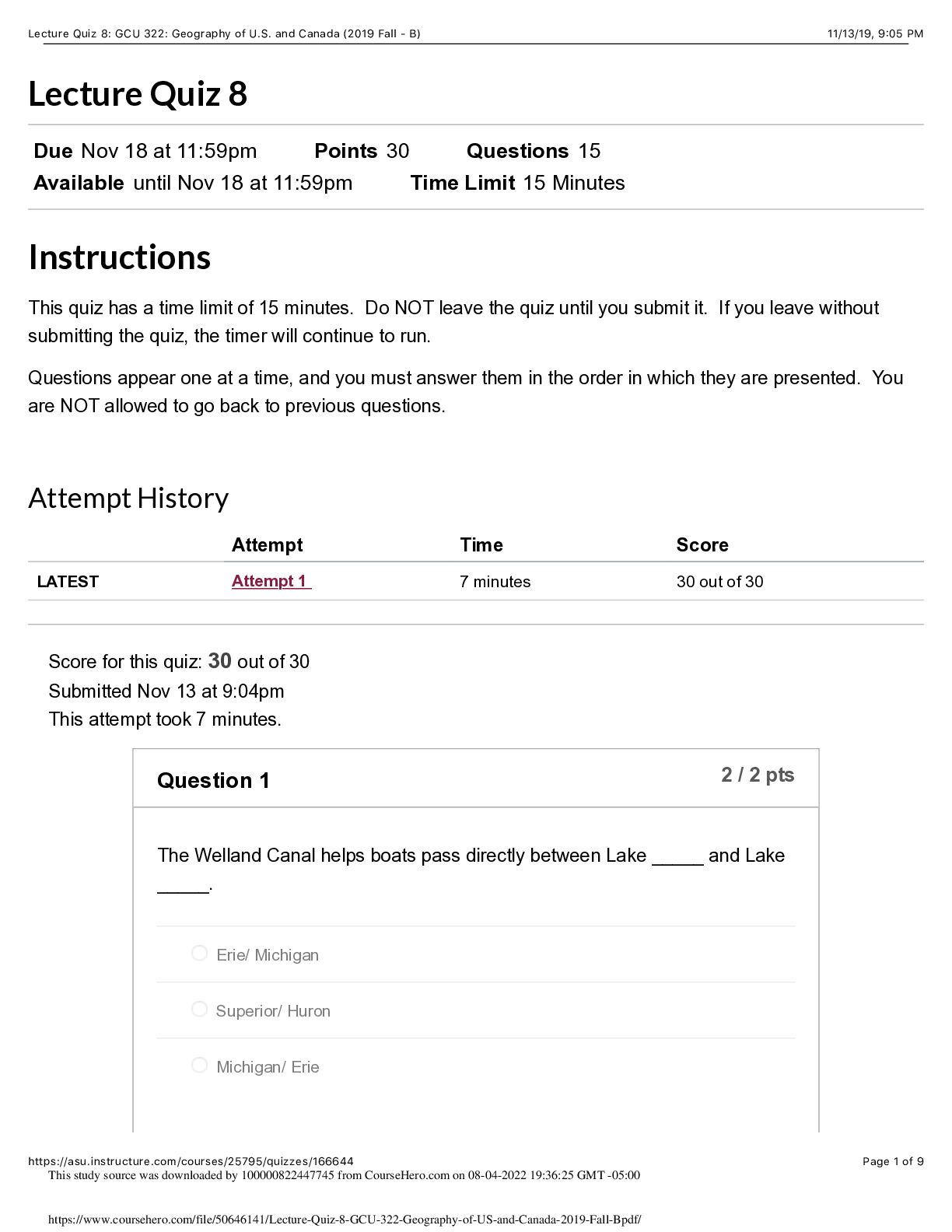
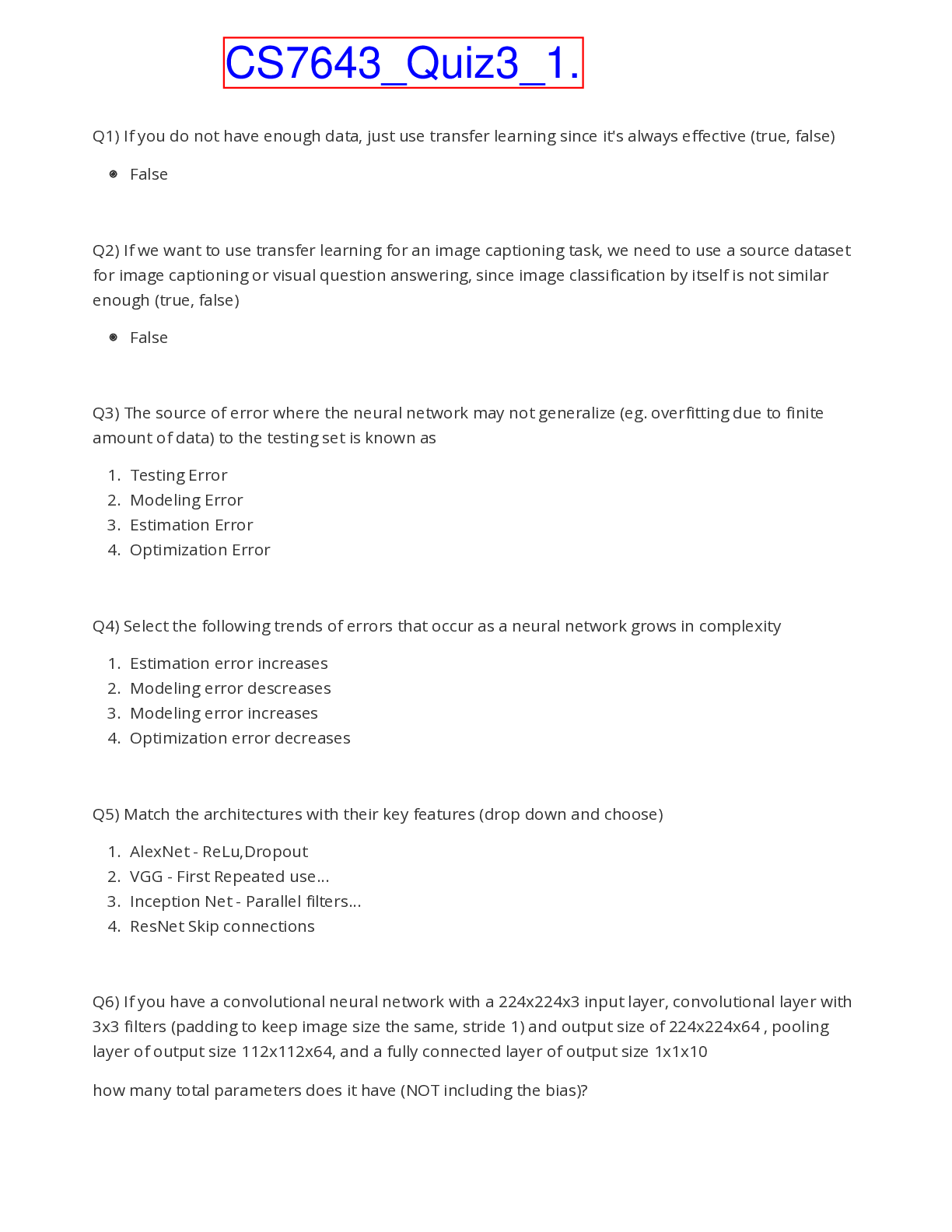
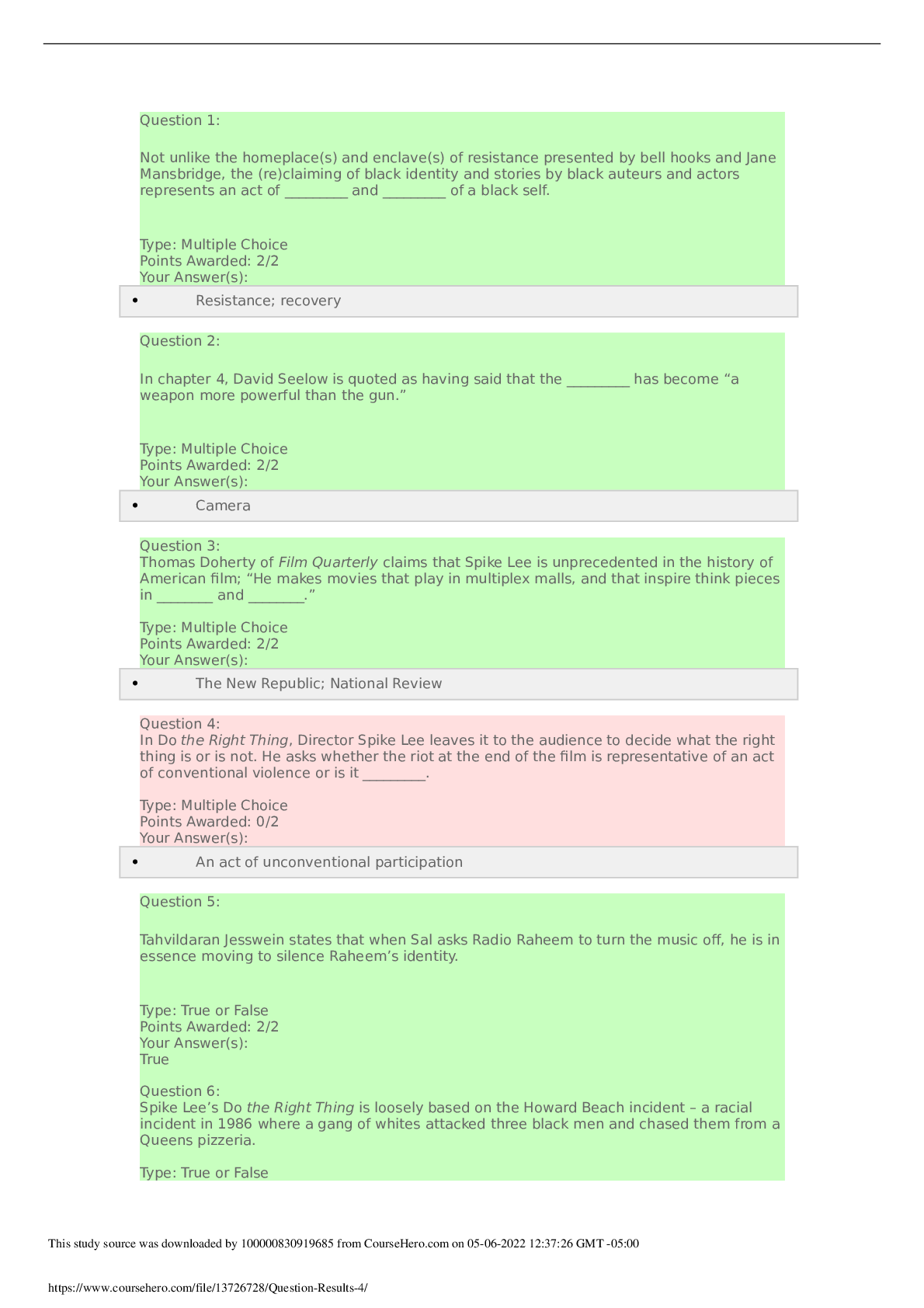
.png)
